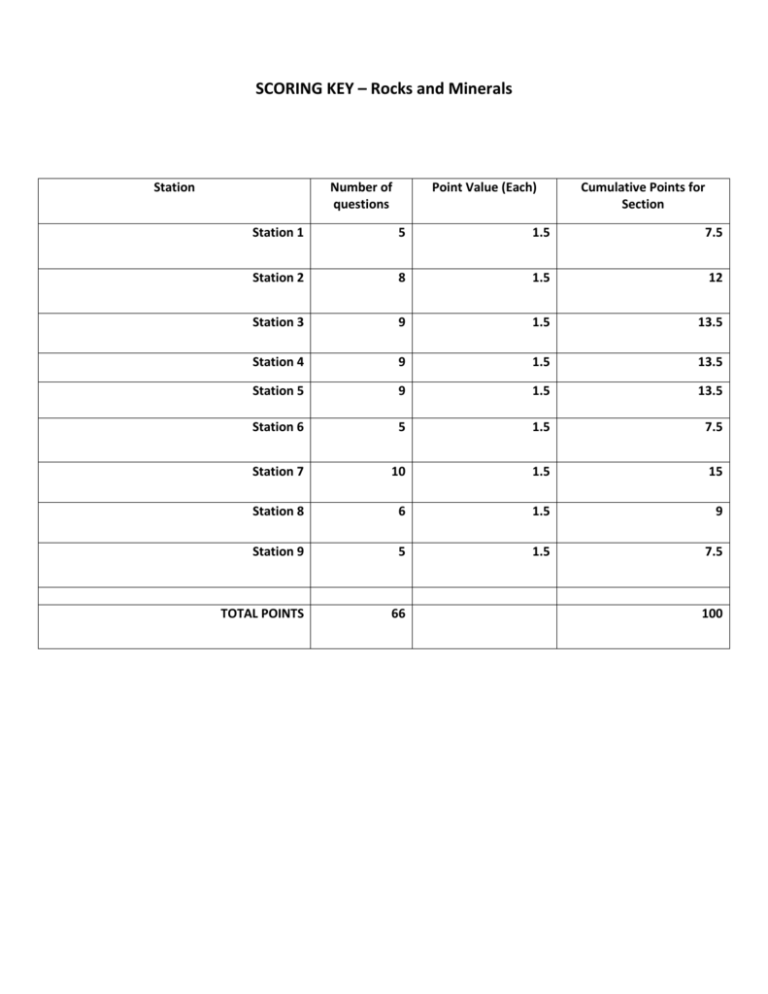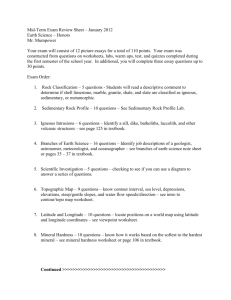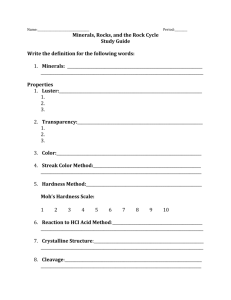Rocks and Minerals Test
advertisement

SCORING KEY – Rocks and Minerals Station Number of questions Point Value (Each) Cumulative Points for Section Station 1 5 1.5 7.5 Station 2 8 1.5 12 Station 3 9 1.5 13.5 Station 4 9 1.5 13.5 Station 5 9 1.5 13.5 Station 6 5 1.5 7.5 Station 7 10 1.5 15 Station 8 6 1.5 9 Station 9 5 1.5 7.5 TOTAL POINTS 66 100 Team # ___________________ School Name____________________________________________ Students Name(s) __________________________________________________________________________________ Cy Falls Invitational Rocks and Minerals Exam Time: 40 min PLEASE PUT ALL ANSWERS DIRECTLY ON THIS TEST IN THE BLANKS PROVIDED! WRITE LEGIBLE. Station 1 – Physical Properties of Minerals Identify the three minerals (a,b,c) at this station and place them in their relative order, from softest to hardest, on Mohs hardness scale. (softest)____________________________________ ____________________________________ (hardest)____________________________________ True or False: The streak of a mineral for identification purposes is most useful when the hardness is about 7. Multiple Choice: Nonmetallic mineral resources include all of the following except a. phosphate b. iron c. gypsum d. limestone e. sulfate Station 2 – Economic Uses of Minerals Identify the mineral and name an economic use for each mineral. Mineral Name a._______________________ b._______________________ c._______________________ Economic Use ____________________________________ ____________________________________ ____________________________________ True/False: Minerals are considered nonrenewable resources because they take so long to form. Short Answer: Explain what it means for a mineral to become economically depleted. (In two sentences or less!) Station 3 – Rock Classification There are 6 rocks at this station. Identify each rock according to its general rock classification (igneous, metamorphic, and sedimentary) and then give each rock a rock name. General Classification Rock Name A____________________________ B____________________________ C____________________________ D____________________________ ___________________________ ___________________________ ___________________________ ___________________________ Multiple Choice: Although often covered by other kinds of rock, which type of rock forms most of the earth’s crust? a. igneous b. mineral c. metamorphic d. sedimentary e. organic Station 4 – Depositional Environments Name these four rocks and describe where they were deposited (e.g., beach, stream, alluvial fan). Rock Name A______________________ B______________________ C______________________ D______________________ Depositional Environment ______________________________________ ______________________________________ _____________________________________ _____________________________________ True/False: Rocks can be converted from one type to another. Station 5 – Economic Uses of Rocks Name the four rocks at this station and give an economic use. Rock Name A______________________ B______________________ C______________________ D______________________ Economic Use ___________________________ ___________________________ ___________________________ ___________________________ Multiple Choice: What branch of Bowen's reaction series cools with a continuous change in composition? a. the iron-magnesium groups b. the carbonates c. the feldspars d. the silica chains Station 6 – Degree of metamorphism Name these metamorphic rocks (a,b,c) and place them in order of increasing metamorphism. _______________________________________________ _______________________________________________ _______________________________________________ Multiple Choice: What type of rocks can include quartz? a. peridotite b. granite c. gabbro d. basalt True/False: A glassy rock cooled the slowest, making a rock with no visible grains. Station 7 – Depth of igneous rock emplacement Name the six rocks at this station and classify them as plutonic, volcanic, or hypabyssal. Rock Name A__________________________ B__________________________ C__________________________ D__________________________ E__________________________ Plutonic, Volcanic, or Hypabyssal? ___________________________ ___________________________ ___________________________ ___________________________ ___________________________ Station 8 – Mineral Identification 1. Identify these two minerals. Which of these two minerals has the higher specific gravity? a. (mineral has been dyed to enhance color) b. 2. What is this mineral? What is the luster of this mineral? c. Multiple Choice: Which mineral is white or colorless, has a hardness of 2.5, and splits with cubic cleavage? a. calcite b. halite c. pyrite d. mica Station 9 – ROCK CYCLE Multiple Choice: (Use diagram labeled A for questions 1-3) 1. The recrystallization of unmelted material under high temperature and pressure results in a. metamorphic rock b. sedimentary rock c. igneous rock d. volcanic rock 2. Which of the following pairs contains one igneous and one sedimentary rock? a. shale and marble b. sandstone and quartzite c. granite and limestone d. obsidian and gneiss 3. What types of rocks can be changed into an igneous rock? a. igneous b. sedimentary c. metamorphic d. all of the above Fill in Blank: (Use diagram labeled B for questions 4-5) 4. Which rock sample is foliated? _________ 5. Which rock sample is the most obvious choice as a sedimentary rock? _________________ TIE BREAKER QUESTIONS: 1. The portion of ore that does not contain the desired mineral is called a. hazardous waste b. spoil c. gangue d. tailings e. smelt 2. What is the last mineral to form on the left branch of Bowen's reaction series? ____________________________________ 3. 4. Of the following, the rock that is most resistant to both chemical and mechanical weathering is: a. shale c. marble b. limestone d. quartzite Which of the following minerals is noted for its one perfect cleavage? a. calcite c. quartz b. muscovite d. pyrite 5. Which one of the following minerals does NOT contain silica tetrahedrons? a. quartz b. muscovite c. halite d. orthoclase 6. True or False: Two examples of Extrusive Igneous Rocks are Obsidian and Pumice.







